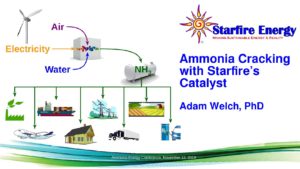Presentation
High Flow Ammonia Cracking between 400-600°C
Traditional ammonia cracking is achieved at 850-950 °C in the presence of a nickel catalyst. The reaction is highly endothermic, and maintaining these high temperatures at high flow rates of ammonia gas can be difficult. Here, we present work using our advanced ammonia synthesis catalyst in an ammonia cracking setup. We use a metallic monolith catalyst support to minimize pressure drop at high flow rates. Full NH3 cracking occurs at 600 °C, with the onset of cracking at 400 °C. An output flame can be achieved with a fully tunable ratio of hydrogen to ammonia, depending on the temperature setpoint…



